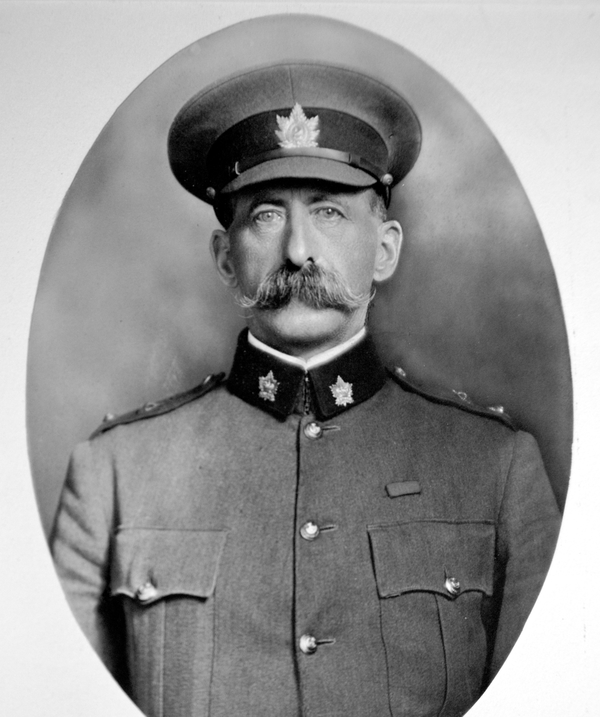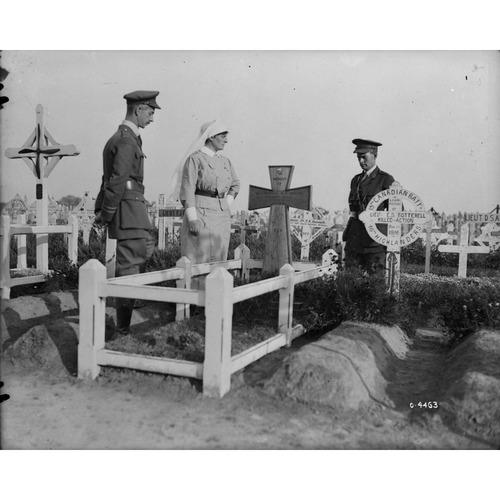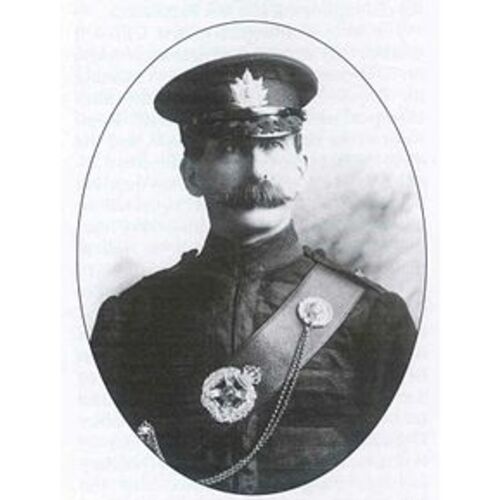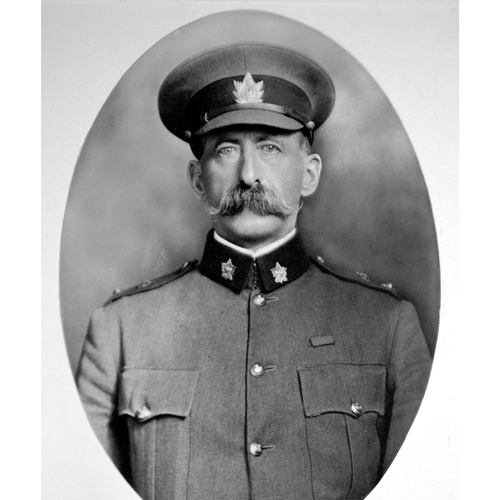As part of the funding agreement between the Dictionary of Canadian Biography and the Canadian Museum of History, we invite readers to take part in a short survey.

Source: Link
MERCER, MALCOLM SMITH, lawyer and army officer; b. 17 Sept. 1859 in Etobicoke Township, Upper Canada, third of the nine children of Thomas Mercer and Mary Smith; d. unmarried June 1916, most probably on the 2nd, near Mount Sorrel, Belgium.
Malcolm Smith Mercer was raised in Delmer, near Tillsonburg, Upper Canada, and in St Catharines, where he attended the Collegiate Institute. He was at the University of Toronto from 1881 to 1885, graduating in philosophy. He entered Osgoode Hall in the latter year and graduated, near the middle of his class, three years later. Called to the Ontario bar in Michaelmas term, 1888, Mercer practised law in Toronto with Samuel Hugh Bradford; subsequent partners included Fernando Elwood Titus and John King, the father of William Lyon Mackenzie King*. Although both Bradford and King served as instructors at Osgoode Hall, Mercer did not play an active public role in his profession. Nor did he marry. His private life was described in an obituary as “quiet and unobtrusive. He avoided publicity, moved little in society and in his legal practice preferred to keep his clients out of court, if he could.”
At university Mercer had joined the 2nd Battalion of Rifles (Queen’s Own Rifles of Canada), one of the most efficient units of the Canadian militia. It chose its recruits carefully, with an eye to their suitability as officers, promoted its officers from the ranks, and combined vigorous social and athletic activity with a serious attitude to training and discipline. Six feet tall and of athletic build, with a heavy, drooping moustache, Mercer would have been an attractive recruit, and, apart from an amateur enthusiasm for painting, he found the chief outlet for his energy and talent as a member of the unit.
Though Mercer did not join the contingent from the QOR sent to help suppress the North-West rebellion in 1885 [see Louis Riel*], he was appointed a provisional lieutenant on 24 April of that year and qualified for this rank on 27 Oct. 1886; promoted lieutenant on 7 April 1887, he was made captain on 16 Oct. 1891. He spent the usual long years as a captain before becoming brevet major on 29 Dec. 1902 and major on 10 April 1906. In October 1903 Mercer had commanded the detachment of the QOR which was part of a force of regulars and militia rushed to Sault Ste Marie to quell a riot of unpaid workers of the Consolidated Lake Superior Corporation. On 1 Feb. 1911 he was promoted lieutenant-colonel when command of the 1st battalion of the regiment became vacant, and later that year he completed the militia staff course. He was appointed commandant of the QOR on 20 Feb. 1912, and he held that position when war was declared on 4 Aug. 1914. Mercer mobilized as a lieutenant-colonel eight days later, leaving his 70-year-old brother as next of kin, assigning a share of his pay to his law office, and accompanying a composite battalion of soldiers from the QOR and 10th Regiment (Royal Grenadiers) to the Valcartier camp near Quebec City. “It is characteristic of the man,” wrote a biographer, “that on the day his regiment paraded at the armouries, at 12.30, to go to Valcartier, he worked in his law office up till twelve o’clock.”
As one of Toronto’s senior officers and a discreet Conservative, Mercer seems to have struck Colonel Samuel Hughes*, the minister of militia and defence, as the logical person to command the four Ontario battalions in the 1st Infantry Brigade of the Canadian Expeditionary Force. The choice seems to have provoked none of the controversy that swirled around some of Hughes’s other appointments. Mercer departed for England in that role, supervised the training of his brigade on Salisbury Plain, and was confirmed as brigadier-general on 4 Feb. 1915, on the eve of the Canadians’ departure for France.
When the raw Canadian Division faced its first serious test at Ypres (Ieper), Belgium, on 22 April, Mercer’s brigade was in reserve at Vlamertinge, several miles behind the line. Two of his battalions were fed into the battle and he was left with almost no role. The next day he obediently sent his men to attack Mauser Ridge and went in person to rage at the nearby French troops whose promised support had not arrived.
Apart from showing his courage under fire, the battle was no test of Mercer’s ability in combat. When Lieutenant-General Edwin Alfred Hervey Alderson* was appointed to command the new Canadian Corps in September and Mercer’s fellow brigadiers Arthur William Currie* and Richard Ernest William Turner* rose to command the 1st and 2nd Canadian Divisions respectively, he remained with the 1st Brigade. However, on 20 November he took command of the corps troops, a collection of units that a month later became the nucleus of the 3rd Canadian Division. A scratch formation that had to shake down on active service, the division included Canada’s only regular infantry, the Royal Canadian Regiment, the already famous Princess Patricia’s Canadian Light Infantry, and four battalions of Canadian Mounted Rifles, which had originally been organized to fight on horseback in Egypt and whose men found little joy in being transformed into footsloggers. The command justified Mercer’s promotion in January 1916 to major-general. By March the division was complete except for artillery. British batteries formerly with the 3rd (Lahore) Division of the Indian army filled the gap.
The first real battle for Mercer’s division was unexpected. On 1 June his CMR battalions held the last part of the Ypres ridge in allied hands, from Mount Sorrel to Hill 62, the top of a spur that stretched west into the allied line between Armagh and Sanctuary woods. It was vital ground and the Germans, bent on distracting the British from their expected Somme offensive farther south, were determined to attack. Even inexperienced troops could eventually see the signs of German preparations. At dawn on 2 June Mercer and Brigadier-General Victor Arthur Seymour Williams* set out to visit Mount Sorrel and Hill 62 to see for themselves. They were with the 4th CMR when the German barrage fell with an unprecedented intensity. A German eyewitness wrote, “The whole enemy position was a cloud of dust and dirt, into which timber, tree trunks, weapons and equipment were continuously hurled up, and occasionally human bodies.”
In the first minutes both generals were affected. Another officer remembered that the bombardment left them “dirty and very white and shaken, also quite deaf.” Williams was badly wounded and, according to the official historian, Mercer’s eardrums were broken by a shell explosion and his leg by a bullet. Lieutenant Lyman Gooderham, Mercer’s aide-de-camp, reported that he helped the general to the edge of Armagh Wood, behind the battalion’s position, and went to get aid. Shortly after noon, German troops advanced almost without resistance, capturing Williams, Gooderham, and a few hundred shaken survivors. Mercer was not among them. On 12–13 June, Canadians retook the lost ground, and on the 16th Mercer’s partially decomposed body was found in Armagh Wood. A staff officer concluded that he had been struck and partly buried by a shell, possibly during the unsuccessful Canadian counter-attack on the night of 2–3 June.
A devoted militia officer and courageous commander, Mercer was known as a man of few words, even temper, and quiet study. His fame rests less on military achievements than on being the senior Canadian commander killed in action in either world war. His death remains a refutation of the title of Charles Yale Harrison*’s book Generals die in bed.
Law Soc. of Upper Canada Arch. (Toronto), 1–2 (Convocation, printed minutes), 1 (1879–92): 174, 202, 226, 254. NA, MG 30, E376; RG 150, Acc. 1992–93/166. Daily Mail and Empire, 23 June 1916, 27 June 1918. Globe, 5 June 1916. The Canadian law list (Toronto), 1890, 1892, 1896, 1898, 1910, 1912. D. G. Dancocks, Welcome to Flanders fields; the first Canadian battle of the Great War: Ypres, 1915 (Toronto, 1988). Desmond Morton, The Canadian general: Sir William Otter (Toronto, 1974), 55–73, 262; Silent battle: Canadian prisoners of war in Germany, 1914–1919 (Toronto, 1992). Nicholson, CEF. Standard dict. of Canadian biog. (Roberts and Tunnell), vol.2. Univ. of Toronto, University of Toronto roll of service, 1914–1918 (Toronto, 1921).
Cite This Article
Desmond Morton, “MERCER, MALCOLM SMITH,” in Dictionary of Canadian Biography, vol. 14, University of Toronto/Université Laval, 2003–, accessed March 29, 2025, https://www.biographi.ca/en/bio/mercer_malcolm_smith_14E.html.
The citation above shows the format for footnotes and endnotes according to the Chicago manual of style (16th edition). Information to be used in other citation formats:
| Permalink: | https://www.biographi.ca/en/bio/mercer_malcolm_smith_14E.html |
| Author of Article: | Desmond Morton |
| Title of Article: | MERCER, MALCOLM SMITH |
| Publication Name: | Dictionary of Canadian Biography, vol. 14 |
| Publisher: | University of Toronto/Université Laval |
| Year of revision: | 1998 |
| Access Date: | March 29, 2025 |





